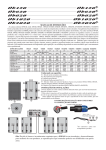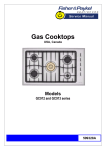Download OB60 User Guide & Installation Instructions
Transcript
Installation instructions and User guide Built-in oven OB60 single, double, and compact models NZ AU GB IE SG Contents Safety and warnings Installation instructions Oven controls and setting the clock First use Using your oven Oven functions Baking charts Cooking with ‘auto-off’ Using the timer Automatic cooking Care and cleaning Warranty and service Important! SAVE THESE INSTRUCTIONS The models shown in this user guide may not be available in all markets and are subject to change at any time. For current details about model and specification availability in your country, please visit our local website listed on the back cover or contact your local Fisher & Paykel dealer. 1 2 4 10 14 15 16 18 22 23 24 25 36 2 Safety and warnings Installation WARNING! Electrical Shock Hazard Always disconnect the appliance from the mains power supply before carrying out any maintenance or repairs. Connection to a good earth wiring system is essential and mandatory. Alterations to the domestic wiring system must only be made by a qualified electrician. Failure to follow this advice may result in death or electrical shock. WARNING! Fire Hazard Do not use adapters, reducers, or branching devices to connect this appliance to the mains power supply. Failure to follow this advice may result in overheating, burning, or fire. WARNING! Cut Hazard Take care - panel edges are sharp. Failure to use caution could result in injury or cuts. Important safety instructions To avoid hazard, follow these instructions carefully before installing or using this appliance. Please make this information available to the person installing the appliance - doing so could reduce your installation costs. This appliance must be installed and connected to the mains power supply only by a suitably qualified person according to these installation instructions and in compliance with any applicable local building and electricity regulations. Failure to install the appliance correctly could invalidate any warranty or liability claims. Safety and warnings 3 Operation and maintenance Your built-in oven has been carefully designed to operate safely during normal cooking procedures. Please keep the following guidelines in mind when you are using your oven: WARNING! Electrical Shock Hazard Switch the oven off at the wall before any cleaning or maintenance. Failure to do so may result in death or electrical shock. WARNING! Hot Surface Hazard Accessible parts may become hot when this oven is in use. To avoid burns and scalds, keep children away. Do not touch hot surfaces inside the oven. Use oven mitts or other protection when handling hot surfaces such as oven shelves or dishes. Take care when opening the oven door. Let hot air or steam escape before removing or replacing food. Failure to follow this advice could result in burns and scalds. Important safety instructions Isolating switch: make sure this oven is connected to a circuit which incorporates an isolating switch providing full disconnection from the power supply. Household appliances are not intended to be played with by children. Children, or persons with a disability which limits their ability to use the appliance, should have a responsible person to instruct them in its use. The instructor should be satisfied that they can use the appliance without danger to themselves or their surroundings. Safe food handling: leave food in the oven for as short a time as possible before and after cooking. This is to avoid contamination by organisms which may cause food poisoning. Take particular care during warmer weather. Do not place aluminium foil, dishes, trays, water or ice on the oven floor during cooking as this will irreversibly damage the enamel. Do not stand on the door, or place heavy objects on it. Do not use harsh abrasive cleaners or sharp metal scrapers to clean the oven door glass since they scratch the surface, which may result in shattering of the glass. Do not use a steam cleaner to clean any part of the oven. Caution. Hot air can blow from under the control panel as part of the oven’s cooling system. Do not keep flammable substances in the oven. 4 Installation instructions OB60S and OB60N models I I C E I K B J J I L D A 16-20 mm H F L G 2.5 mm Installation diagrams for illustration purposes only Fig. 1 OB60S and OB60N product and cabinetry dimensions G H I II J JI K L overall height* of product overall width of product overall depth of product (excluding handle and knobs) height of chassis width of chassis depth of chassis depth of oven frame and control panel (=distance between front of chassis and front of oven door, excl. knobs) depth of oven door when fully open (measured from front of control panel) minimum inside width of cavity overall width of cavity inside height of cavity overall height of cavity minimum inside depth of cavity flush fitting cabinetry clearance OB60N A B C D E F OB60S Product and cabinetry dimensions (mm) 597 595 567 582 556 545 450** 595 556 436 536 532 22 22 435 560 600 585 600 550 22 289 560 600 440** 455** 550 22 Note: If installing a cooktop above the oven, ensure adequate clearance is provided for the cooktop as per the cooktop manufacturer’s instructions. *All height measurements include mounted feet. ** If fitting the lower trim extension kit, the overall height of product (A) increases by 25 mm (to 475 mm). The height of the cavity (J and JI) therefore needs to be increased by 25 mm also (to 465 mm and 480 mm respectively). Installation instructions 5 OB60B and OB60D models I I C I E B J J A I K L H D 16-20 mm H I L F G 2.5 mm Fig. 2 OB60B and OB60D product and cabinetry dimensions G overall height* of product overall width of product overall depth of product (excluding handle and knobs) height of chassis width of chassis depth of chassis depth of oven frame and control panel (=distance between front of chassis and front of oven door, excl. knobs) H depth of upper oven door when fully open (measured from front of control panel) HI depth of lower oven door when fully open (measured from front of control panel) I minimum inside width of cavity I I overall width of cavity J inside height of cavity overall height of cavity JI K minimum inside depth of cavity L flush fitting cabinetry clearance *All height measurements include mounted feet. OB60D A B C D E F OB60B Product and cabinetry dimensions (mm) 888 595 567 874 556 545 1077 595 567 1057 556 545 22 22 261 435 560 600 877 893 550 22 435 450 560 600 1065 1082 550 22 6 Installation instructions Before you install the oven, make sure that the benchtop and oven cavity are square and level, and are the required dimensions the installation will comply with all clearance requirements and applicable standards and regulations a suitable isolating switch providing full disconnection from the mains power supply is incorporated in the permanent wiring, mounted and positioned to comply with the local wiring rules and regulations. The isolating switch must be of an approved type and provide a 3 mm air gap contact separation in all poles (or in all active [phase] conductors if the local wiring rules allow for this variation of the requirements) the isolating switch will be easily accessible to the customer with the oven installed there is at least 1.5 m (and not more than 2 m) free length of power supply cable within the cavity for ease of installation and servicing the oven connection socket (if fitted) is outside the cavity if the oven is flush to the rear wall the oven will rest on a surface that can support its weight the height from the floor suits the customer you consult local building authorities and by-laws if in doubt regarding installation. When you have installed the oven, make sure that the oven door can open fully without obstruction the power supply cable does not touch any hot metal parts the isolating switch is easily accessible by the customer you complete the ‘Final checklist’ at the end of these installation instructions. Unpacking the oven Remove all packaging and dispose of it responsibly. Recycle items that you can. When you remove the oven from the carton, place it onto wooden blocks or similar supports to prevent damaging the lower trim. Important! Please take extra care not to damage the lower trim of the oven. It is important for correct air circulation and allows the door to open and close without obstruction. The manufacturer does not accept any responsibility for damage resulting from incorrect installation. You may remove the feet but ensure that the oven does not sit on the lower trim. LOWER TRIM OVEN DOOR LOWER TRIM AIR FLOW Fig. 3 Correct and incorrect placement of lower trim Feet Installation instructions 7 Connecting the oven to the mains power supply Important! This oven must be connected to the mains power supply only by a suitably qualified person. This oven must be earthed. Before connecting the oven to the mains power supply, check that the domestic wiring system is suitable for the power drawn by the oven (as specified on the rating plate) the voltage corresponds to the value given on the rating plate. OB60S and OB60N models OB60B and OB60D models Model code Power Voltage Model code Power Voltage OB60SL... 2350 - 2550 W 230 - 240 V~ OB60BC... 4400 - 4800 W 230 - 240 V~ OB60SC... 2350 - 2550 W 230 - 240 V~ OB60BD... 4400 - 4800 W 230 - 240 V~ OB60SD... 2350 - 2550 W 230 - 240 V~ OB60B77C... 5850 W 220 - 240 V~ OB60SV... 2350 - 2550 W 230 - 240 V~ OB60B77D... 5850 W 220 - 240 V~ OB60NL... 2050 W 220 - 240 V~ OB60DD... 6120 W 220 - 240 V~ OB60NC... 2800 W 220 - 240 V~ OB60ND... 2800 W 220 - 240 V~ 1 Unscrew to remove cover plate 1 Unhook to open cover 2 2 L N Brown (Live) Unscrew to open cable clamp D Blue (Neutral) Green & Yellow (Earth) Unscrew to remove cable clamp L1 N (L2 ) E L1 N (L 2) E 8 Installation instructions Securing the oven to the cabinetry 1 Position the oven in the prepared cavity. Important! 2 3 Do not lift the oven by the door handle. Open the oven door fully. Use the supplied screws to secure the oven to the cabinetry. Important! Do not over-tighten the screws. Do not seal the oven into the cabinetry with silicone or glue. This makes future servicing difficult. Fisher & Paykel will not cover the costs of removing the oven, or of damage caused by this removal. 2.5 mm Fig. 4 Securing the oven to the cabinetry Installation instructions Final checklist TO BE COMPLETED BY THE INSTALLER Make sure the oven is level and securely fitted to the cabinetry. Check the lower trim is still undamaged. Open the oven door slowly to its fully open position and check if there is adequate clearance between the bottom of the door and the lower trim. This is to ensure correct air circulation. Should the lower trim become damaged, straighten the trim and ensure the oven door opens fully without obstruction. Turn the power to the oven on. 0.00 will flash in the clock display. Advise the customer to set the clock and condition the oven, following the instructions under ‘First use’ in the user guide. Installer’s name: Installer’s signature: Installation company: Date of installation: LEAVE THESE INSTRUCTIONS WITH THE CUSTOMER 9 MODELS WITH THREE-BUTTON CLOCK 10 Oven controls and setting the clock Clock display Control buttons Temperature indicator light Temperature knob Function indicator light Function knob Fig. 5 Control panel- Compact models with two cooking functions Temperature indicator light Temperature knob Clock display Function indicator light Function knob Fig. 6 Control panel- Single models with four cooking functions 11 Buttons sets the clock, shows the time of day when oven is cooking with ‘auto-off’ set decreases time and beep volume increases time Fig. 7 Clock display and control buttons Illuminated symbols AUTO flashing: oven is ready to be set for cooking with ‘auto-off’ AUTO steadily lit: oven is cooking with ‘auto-off’ set To set the clock 1 2 When first connected, or after a power failure, 0.00 will flash in the display. Press . Press and until you have the correct time of day. MODELS WITH THREE-BUTTON CLOCK Oven controls and setting the clock 12 Oven controls and setting the clock MODELS WITH SIX-BUTTON CLOCK Control buttons Function indicator light Temperature indicator light Clock display Temperature knob Function knob Fig. 8 Control panel- Compact models with seven cooking functions Control buttons Function indicator light Temperature indicator light Clock display Temperature knob Function knob Fig. 9 Control panel- Single models with seven cooking functions 8 1 7 2 6 3 4 5 Fig. 10 Control panel- Double models with seven-function full oven and two-function compact oven 8 1 7 2 6 3 4 5 Fig. 11 Control panel- Double models with two seven-function ovens (full or compact upper oven) 1 2 3 4 Control buttons Upper oven function knob Upper oven temperature knob Lower oven function knob 5 6 7 8 Lower oven temperature knob Lower oven temperature indicator light Upper oven temperature indicator light Clock display 13 Buttons sets the timer sets the cooking time for automatic cooking sets the stop time for automatic cooking sets the clock, returns oven to manual mode, cancels automatic cooking decreases time and beep volume increases time Fig. 12 Clock display and control buttons Illuminated symbols AUTO flashing: oven is ready to be set for automatic cooking or the clock needs to be set (after a power failure) AUTO steady lit: oven is set for automatic cooking timer in operation AUTO flashing and timer beeping when you have set the stop time for automatic cooking: program error (The time of day lies between the cooking start and the stop time.) To set the clock 1 2 When first connected, or after a power failure, 0.00 and AUTO will flash in the display. Press . Press and until you have the correct time of day. MODELS WITH SIX-BUTTON CLOCK Oven controls and setting the clock 14 1 2 3 4 First use Before using your new oven, please: Read this user guide, taking special note of the ‘Safety and warnings’ section. Remove all accessories and packaging. Make sure you peel the protective film off all surfaces. Set the clock. The oven will not work until the clock has been set. See ‘Oven controls and setting the clock’ for instructions. Condition the oven: Slide in the shelf/shelves and grill tray as shown in Fig.13 below. Fit them between the metal wires of the side racks, with the safety stop notch down and at the back. If you have catalytic panels and sliding shelf supports, make sure these are fitted too. See ‘Care and cleaning’ for instructions if they are not already fitted. Heat the oven on maximum temperature for the times below (see ‘Using your oven’): 60 minutes using 30 minutes using 15 minutes using Note: some of these functions may not be available in some models. There will be a distinctive smell during the conditioning. This is normal, but make sure your kitchen is well ventilated. 5 Once cooled, wipe out the oven with a damp cloth and mild detergent, and dry thoroughly. Shelf positions 4 3 4 3 2 2 1 1 Fig. 13 Correct position of shelves and grill tray - full and compact ovens Using your oven 15 To start cooking 1 Select the function. The oven light(s) will come on. In single and compact models, the function indicator light will also come on. 2 Set the temperature. The temperature indicator light will come on. It will go out when the oven has reached the set temperature. The temperature indicator light may come on and go out again during cooking as the oven maintains the temperature. Fig. 14 Turning the function knob (functions and knobs may vary) Fig. 15 Turning the temperature knob (knobs may vary) When you have finished cooking Turn both the function and temperature knobs to the off (O) position. If AUTO is flashing or steadily lit, press (six-button clock models only). to return the oven to manual mode Notes: Set the temperature back to off (O) before changing functions during cooking. A cooling fan may automatically come on at different times during cooking and blow out warm air below the control panel. It may continue to run even after the oven has been turned off. This is normal. 16 Oven functions Depending on your model, your may only have some of these functions. OVEN LAMP Only the oven light comes on. It remains on in all the cooking functions. BAKE This is the traditional method of baking. It is best to bake on only one shelf at a time in this function. Ideal for large cakes and dishes that bake for several hours. GRILL Use with the oven door closed and the temperature set no higher than 225°C. For best results, use the topmost shelf position when you want quick browning (eg toast). DEFROST Only the oven fan comes on. Use with the temperature set to 0. The fan circulates air around the oven, speeding up the defrosting process by approximately 30%. Note: this function is not for cooking food. FAN FORCED Great for multi-shelf cooking. The consistent temperature ensures baking is well risen. Cookies are crisp on the outside and chewy in the middle, meat and poultry are deliciously browned and sizzling while remaining juicy and tender. FAN GRILL Use with the oven door closed and the temperature set no higher than 220°C. Ideal for roasting tender cuts of meat and poultry. Use the lower shelf positions for larger items eg a whole chicken. or WARM Use this function to keep cooked food hot and to warm plates and serving dishes. To reheat food from cold, set the temperature to 150°C and reduce it to 70-100°C only when the food is piping hot. Note: this function is not for cooking food and the temperature cannot be set higher than 150°C. FAN BAKE Ideal for dishes like lasagne that need to brown on top and also single trays of small cakes or biscuits that bake in less than an hour. Oven functions 17 Important! Safe food handling: leave food in the oven for as short a time as possible before and after cooking or defrosting. This is to avoid contamination by organisms which may cause food poisoning. Take particular care during warmer weather. Notes on baking: Preheat the oven before baking. Do not place anything, including water or ice, on the oven floor. Remove the fat filter before baking (some models only). Notes on using the fat filter (some models only): Use the fat filter only when roasting meat and poultry on FAN BAKE, FAN GRILL or FAN FORCED. It helps to keep your oven clean and reduces splatter and smoking. Clean the fat filter after every use. See ‘Care and cleaning’. Remove the fat filter before baking. Important! If the fat filter is not cleaned after every use, the grease build-up will block and shorten the life of the fan element. Fig. 16 Fat filter (not supplied with all models) 18 Baking charts Please note: The settings in the following charts are guidelines only. Follow the instructions in your recipe or on packaging and be prepared to adjust the oven settings and baking times to achieve the best possible results for you. Shelf positions are counted from the base up (1 is the lowest, 4 the highest). Arrange oven shelves before you turn the oven on, then preheat the oven to the required temperature (until the temperature indicator light goes out). Full ovens are ideal for multi-shelf baking or larger items. Compact ovens are the ideal and most energy-efficient choice for baking small or flat items (eg cookies, pizza) on a single shelf; however, they have not been designed for multi-shelf baking. Settings in bold indicate the recommended oven function. Baking chart - full ovens The shelf positions recommended below use the flat oven shelf (not the step-down shelf ) used either with or without sliding shelf supports. Note: the step-down shelf and sliding shelf supports are not supplied with all models. BAKE Food Small cakes Scones Sponge Light fruit cake Rich fruit cake single shelf Shelf position Temperature (OC) Time (mins) 2 180-190 13-17 multi shelf single shelf not recommended 2 multi shelf 210-230 8-12 not recommended two small (20 cm), staggered on shelf 2 170-190 25-35 one large (26 cm) 2 175 30-40 2 155-165 80-100 exact baking time 2 will depend on size 130-150 3-6 hours Apple pie 1 185 35-45 Custard tart 1 220, then 180* 10, then 20-30* * This is a two-stage baking process: adjust the temperature after the first stage. continued... Baking charts Baking chart - full ovens FAN BAKE Food Small cakes Scones Sponge single shelf Shelf position Temperature (OC) Time (mins) 2 150-170 13-17 2 200-220 multi shelf single shelf not recommended multi shelf 8-12 not recommended two small (20 cm), staggered on shelf 2 160-175 20-30 one large (26 cm) 2 150 30-40 2 150-160 80-100 Light fruit cake Rich fruit cake not recommended Apple pie 1 Custard tart 160 35-45 not recommended FAN FORCED Food Small cakes Scones Sponge Light fruit cake Rich fruit cake Apple pie Custard tart Shelf position Temperature (OC) Time (mins) single shelf 2 150-170 13-17 multi shelf 1 and 4** 150-170 15-20 single shelf 2 210-230 8-12 multi shelf 1 and 4** 210-230 10-14 two small (20 cm), staggered on shelf 2 170-190 25-35 one large (26 cm) 2 175 30-40 2 155-165 80-100 exact baking time 2 will depend on size 130-150 3-6 hours 185 35-45 1 not recommended ** Use the flat shelf in position 1 and the step-down shelf in position 4. 19 20 Baking charts Baking chart - compact ovens The shelf positions recommended below use the step-down shelf without sliding shelf supports. BAKE Food Shelf position Temperature (OC) Time (mins) Small cakes 2 180-190 13-17 Scones Sponge Light fruit cake Rich fruit cake 2 210-230 8-12 two small (20 cm), staggered on shelf 2 170-190 25-35 one large (26 cm) 2 175 30-40 2 155-165 80-100 exact baking time 2 will depend on size 130-150 3-6 hours Apple pie 1 185 35-45 Custard tart 1 220, then 180* 10, then 20-30* * This is a two-stage baking process: adjust the temperature after the first stage. continued... Baking charts Baking chart - compact ovens FAN BAKE Food Shelf position Temperature (OC) Time (mins) Small cakes 2 150-170 13-17 Scones Sponge 3 200-220 8-12 two small (20 cm), staggered on shelf 2 160-175 20-30 one large (26 cm) 2 150 30-40 2 150-160 80-100 Light fruit cake Rich fruit cake not recommended Apple pie 1 Custard tart 160 35-45 not recommended FAN FORCED Food Shelf position Temperature (OC) Time (mins) Small cakes 2 150-170 13-17 Scones 2 210-230 8-12 two small (20 cm), staggered on shelf 2 170-190 25-35 one large (26 cm) 2 175 30-40 2 150-160 80-100 exact baking time 2 will depend on size 130-150 3-6 hours 185 35-45 Sponge Light fruit cake Rich fruit cake Apple pie Custard tart 1 not recommended 21 MODELS WITH THREE-BUTTON CLOCK 22 Cooking with ‘auto-off ’ Use ‘auto-off’ to automatically turn the oven off when the set cooking time has elapsed. To set the oven for cooking with ‘auto-off’ 1 2 Set the oven: Check the clock shows the correct time (eg 12:07). Select the function and set the temperature. The oven will turn on. Fig. 17 Three-button clock display and control buttons Set the cooking time: Decide how long the food will take to cook, allowing time for preheating if necessary (eg 40 minutes). Press . While AUTO is flashing, use and to set the cooking time (eg 40 minutes). Notes on setting the cooking time If the cooking time is 99 minutes or less: you can set it in 10-second steps the remaining time will count down in seconds (min.sec). If the cooking time is 100 minutes (ie 1 hour 40 minutes) or more: you can set it in 1-minute steps the remaining time will start counting down in minutes (h.min). When ‘auto-off’ is set The time will start counting down and the clock display will show the remaining time with AUTO steadily lit. To see the current time of day, press . To cancel the ‘auto-off’ setting, press and together. The current time of day will appear in the display. Turn the function and temperature knobs to O (off ). When the cooking time is over The oven will automatically turn off (eg at 12:47). AUTO will start flashing, the current time of day will appear in the display and the timer will beep: 1 2 Press any button to stop the beeping and return the oven to manual mode. Turn the function and temperature knobs to O (off ). 23 You can use the timer at any time, even when the oven is not in use. Important! The timer does NOT turn the oven off. To set the timer 1 2 Press . 0.00 will show and the symbol will start flashing. Press and to set the time you want (up to 23 hours and 59 minutes, in 1-minute steps). After a few seconds, the clock will show the time of day with the symbol steadily lit. The timer is now counting down. Fig. 18 Six-button clock display and control buttons To check the remaining time Press . To cancel the timer 1 2 Press . Press until the time is reset to 0.00 After a few seconds, the clock will show the time of day. When the set time is up The timer will beep and the symbol will flash. Press to stop the beeping and turn the timer off. After a few seconds, the clock will show the time of day. To adjust the beep volume Press to hear the next volume level. The last one selected will be stored. MODELS WITH SIX-BUTTON CLOCK Using the timer MODELS WITH SIX-BUTTON CLOCK 24 Automatic cooking Important! In double models with compact upper ovens, only the lower (main) oven can be set for automatic cooking. In double models with two full ovens, only the upper oven can be set for automatic cooking. To set the oven for automatic cooking 1 Fig. 19 Six-button clock display Set the oven: and control buttons Check the clock shows the correct time (eg 12:07). Select the function and set the temperature. The oven will turn on. 2 Set the cooking time: Decide how long the food will take to cook, allowing time for preheating if necessary (eg 40 minutes). Press . Use and to set the cooking time. AUTO will show in the display. 3 Set the stop time: Decide when you want your food to be ready by (eg 13:30). Press . Use and to set the stop time. You can turn the oven on manually and set it to turn off automatically by setting the stop time (step 3 above). When automatic cooking is set If there is time before cooking starts, the oven will turn off and the current time of day and AUTO will show in the clock display, indicating that the oven is set for automatic cooking. Note: the cooling fan may stay on. The oven will automatically turn on at the required time (eg 12:50) and turn off at the set stop time (eg 13:30). To see the remaining cooking time, press . To see the set stop time, press . To cancel automatic cooking, press and turn the function and temperature knobs to 0 (off ). When the stop time is reached The oven will turn off, the timer will beep and AUTO will flash. 1 2 Press to stop the beeping and return the oven to manual mode. Turn the function and temperature knobs to O (off ). Care and cleaning 25 Important! Always switch the power to the oven off at the wall before any cleaning or maintenance. When you switch the power back on after cleaning, you will have to set the clock. Do not use abrasive cleaners, cloths or pads to clean any part of your oven. Some nylon scourers may also scratch. Check the label. See the following pages for instructions on removing and refitting different parts of the oven for cleaning. Before cleaning, make sure the oven is a safe temperature to touch. Do not use a steam cleaner. What? How? General advice Stainless steel surfaces Wipe out the oven after every use. Wipe up spills as soon as the oven is a safe temperature to touch. 1 2 3 Wipe the soiling off with a cloth using a mild household detergent or stainless steel cleaner. Wipe the surface dry. Use a suitable stainless steel polish. Glass surfaces Wipe with a damp cloth or use a glass cleaner. Oven cavity (enamel) 1 2 3 4 Side racks, oven shelves, trays Remove everything from the oven: all shelves and trays, the side racks and the catalytic panels and fat filter if supplied. Remove the oven door (see instructions on following pages). Wipe the inside of the oven using a household detergents or an ammonia-based cleaner. Wipe clean with a damp cloth and allow to dry completely. Clean these using a solution of detergent and hot water. They are also dishwasher safe. If badly soiled, soak in a solution of hot water and biological clothes washing powder to make cleaning easier. Important! Avoid leaving alkaline or acidic substances (such as lemon juice, vinegar or salty spills) on the oven surfaces. Do not use cleaning products with a chlorine or acidic base. Immediately wipe off any caustic cleaners if they are spilled onto the oven door handle or the knobs. Do not use harsh abrasive cleaners or sharp metal scrapers since they scratch the surface and may result in the glass shattering. To make cleaning easier, the grill element in some ovens drops down after you have removed the side racks. If using ‘off the shelf’ oven cleaners, always follow the manufacturer’s instructions. 26 Care and cleaning What? How? Important! Side catalytic panels (not supplied with all models) Either remove the side racks and reverse the panels or heat the oven at 250oC on for 60-90 minutes and they will self-clean. These panels absorb and eliminate greasy splashes at high-temperature cooking. They do not normally require cleaning. Clean only if they remain dirty after you have cooked very fatty foods. Sliding shelf supports (not supplied with all models) Wipe with a damp cloth and mild detergent. Do not wipe off or wash away the white lubricating grease (visible when the slides are extended). Do not wash these in the dishwasher, immerse in soapy water, or use oven cleaner on them as doing so will remove the white lubricating grease and prevent the slides from running smoothly. Fat filter (not supplied with all models) If lightly soiled: wash in dishwasher (normal cycle). If heavily soiled: Place under water in a pan. Add two tablespoons of clothes washing powder. Bring to the boil. Leave to soak for 30 minutes. Rinse in clean water and dry. Clean after every use. If the filter is not cleaned, the grease build-up will block and shorten the life of the fan element. Rubber seal framing the oven cavity Wipe very gently with a damp cloth and mild detergent. Take care not to unhook and displace the rubber seal while cleaning it. Take care not to spray any oven cleaner or other caustic cleaner on the rubber seal, as doing so may damage the rubber. Knobs 1 1 2 3 4 5 2 Wipe with a damp cloth and Do not use stainless steel or oven mild detergent. cleaner on the knobs, as doing so may Dry thoroughly with a soft cloth. damage their coating. Care and cleaning 27 Removing and refitting the side racks and catalytic panels Note: only some models have catalytic panels and a lamp in the left oven wall. Fig.20a Side rack and catalytic panel in full oven cavity Fig.20b Side rack in compact oven cavity When refitting the side racks, make sure they are the right way up, as in the illustrations. When refitting the catalytic panels, make sure that: the arrows are pointing upwards the panel with the hole is on the left oven wall (if there is a lamp in the wall). Note: in some models, the back of the oven is also a catalytic panel, but this is not reversible and should not be removed. Drop-down grill element (some models) Once you have removed the side racks, the grill element in some full ovens drops down (Fig. 21) The grill element itself is self-cleaning. Note: some grill elements are fixed. Fig.21 Drop-down grill element 28 Care and cleaning Removing and refitting the sliding shelf supports (some models only) Important! Remove the side racks first to make removing the sliding shelf supports easier. When refitting the sliding shelf supports, make sure that you fit the side racks first the slides to the top wire of a shelf position. They do not fit on the lower wire both sides of each pair of slides both slides on the same level. Notes: In some full ovens, you cannot fit the slides to the topmost shelf position. In a compact oven, you can only fit the slides on the wire immediately below the side rack fixing screws. Clip on 1 Unclip 2 1 Fig.22 Removing the sliding shelf supports Fig.23 Refitting the sliding shelf supports - full oven cavity Care and cleaning Removing and refitting the glass panes of the oven door Important! Oven doors vary. Some have three glass panes, others only two. The outer pane is not removable. Take care, the glass panes are heavy. Place the removed glass panes on a safe, soft surface. To remove the glass panes 1 Open the door fully. 2 Open the levers. 3 Close door until the levers hook to the door. 4 Remove seal (some doors only). Lever Seal Hook into 29 30 Care and cleaning ....then depending on your model... MODELS WITH INNER PANE ONLY 5 Slide out the inner pane. MODELS WITH INNER AND MIDDLE PANES 5 Slide out the inner pane. 6 Slide the middle pane up slightly to unhook it from the bottom clamps. 7 Lift out the bottom edge and remove. 1 2 Care and cleaning 31 To refit the glass panes MODELS WITH INNER PANE ONLY MODELS WITH INNER AND MIDDLE PANES 1 Make sure the open levers firmly hook to the door. 1 Make sure the open levers firmly hook to the door. 2 Check the rubber pads are in place. 2 Check the rubber pads are in place. Rubber pads 3 Rubber pads Check the pane is the right way up. 3 1 Check the pane is the right way up. 1 cont.... 32 Care and cleaning MODELS WITH INNER PANE ONLY 4 Insert the pane into the slide guides and slide it to the bottom retainers. MODELS WITH INNER AND MIDDLE PANES 4 Insert the pane into top clamps then lower and slide into bottom clamps. Slide guides 3 F Bottom retainers 1 2 1 5 Replace the seal (some doors only). 5 Check the rubber pads are in place. Seal Rubber pads 6 6 Check the pane is the right way up. Open the door fully and close the levers. Lever 1 cont.... Care and cleaning MODELS WITH INNER PANE ONLY 33 MODELS WITH INNER AND MIDDLE PANES 7 Insert the pane into the slide guides and slide it to the bottom retainers. Slide guides F Bottom retainers 8 Replace the seal (some doors only). Seal 9 Open the door fully and close the levers. Lever Care and cleaning 34 Removing and refitting the oven door Important! Take care, the oven door is heavy! To remove the door 1 Open the door fully. 2 Open the levers. 4 Close the door until the levers hook to it. 5 Disengage the hinges and remove the door. Lever Hook into 3 C Hold the door. To refit the door Repeat these steps in reverse order. Care and cleaning 35 Replacing the oven lamp Note: oven bulb replacement is not covered by your warranty. 1 2 Let the oven cavity and the grill element cool down. Switch the power to the oven off at the wall. LEFT LAMP (some models only) 3a Remove the left side rack (and catalytic panel if supplied). See ‘Removing and refitting the side racks and catalytic panels’. 4a Press down on the lamp cover and rotate to remove. Important! Never use screwdrivers or other utensils to remove the lamp cover, as doing so could damage the surrounding enamel. Only use your hands. 5a Unscrew and replace the bulb with a new one suitable for high temperatures (300oC) with the following specifications: 230-240V, 50Hz, E14 and same wattage as the bulb being replaced (check wattage stamped on the bulb). 6a Refit the lamp cover, operating in reverse order. Make sure that it clicks into place. Important! The notch in the inner edge of the cover must be on the side closer to the back of the oven. 7a Refit the left side rack (and the left catalytic panel if supplied). 8a Switch the power to the oven back on at the wall. TOP RIGHT LAMP 3b Twist the lamp cover off. 4b Unscrew and replace the bulb with a new one suitable for high temperatures (300oC) with the following specifications: 230-240V, 50Hz, E14 and same wattage as the bulb being replaced (check wattage stamped on the bulb). 5b Twist the lamp cover back on. 6b Switch the power to the oven back on at the wall. 1 2 LEFT LAMP (some models only) Fig.24 Removing the oven lamps 36 Warranty and service Before you call for service or assistance ... Check the things you can do yourself. Refer to the installation instructions and your user guide and check that: 1 2 your product is correctly installed. you are familiar with its normal operation. If after checking these points you still need assistance or parts, please refer to the Service & Warranty book for warranty details and your nearest Authorised Service Centre, or contact us through our local website listed on the back cover: This oven has been designed and constructed in accordance with the following codes and specifications: In New Zealand and Australia: AS/NZS 60335-1 General Requirements for Domestic electrical appliances AS/NZS 60335-2-6 Particular Requirements for Domestic electrical cooking appliances AS/NZS 1044 Electromagnetic Compatibility Requirements. In Europe: Safety requirements of EEC Directive “Low voltage” 2006/95: - EN 60335-1 General Requirements for Domestic electrical appliances - EN 60335-2-6 Particular Requirements for Domestic electrical cooking appliances Safety requirements of EEC Directive “EMC” 89/336: - EN 55014-1, EN 55014-2, EN 61000-3-2, EN 61000-3-3 Electromagnetic Compatibility Requirements Requirements of EEC Directive 93/68. European directive 2002/96/EC on Waste Electrical and Electronic Equipment (WEEE) (for European Union countries only) GB This appliance is marked according to the European directive 2002/96/EC on Waste Electrical and Electronic Equipment (WEEE). By ensuring this product is disposed of correctly, you will help prevent potential negative consequences for the environment and human health, which could otherwise be caused by inappropriate waste handling of this product. The symbol on the product, or on the documents accompanying the product, indicates that this appliance may not be treated as household waste. Instead it shall be handed over to the applicable collection point for the recycling of electrical and electronic equipment. Disposal must be carried out in accordance with local environmental regulations for waste disposal. For more detailed information about treatment, recovery and recycling of this product, please contact your local city office, your household waste disposal service or the shop where you purchased the product. Copyright © Fisher & Paykel 2008. All rights reserved. The product specifications in this booklet apply to the specific products and models described at the date of issue. Under our policy of continuous product improvement, these specifications may change at any time. You should therefore check with your Dealer to ensure this booklet correctly describes the product currently available. www.fisherpaykel.co.nz www.fisherpaykel.com.au www.fisherpaykel.co.uk www.fisherpaykel.ie www.fisherpaykel.com.sg NZ AU GB IE SG Built-in oven user guide Published: 12/2008 Part No. 599606 B F&P Italy Part No. 1103204 - ß2


























































